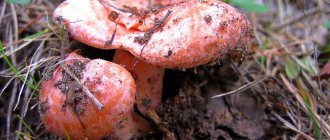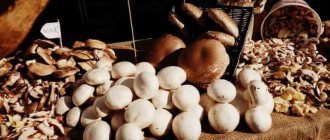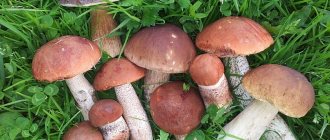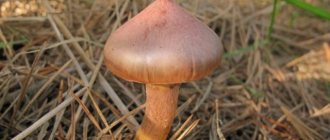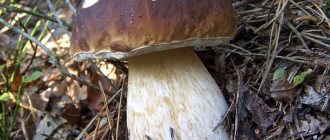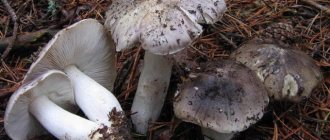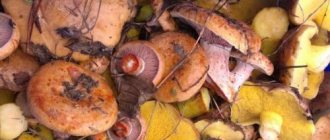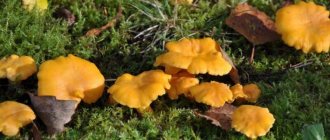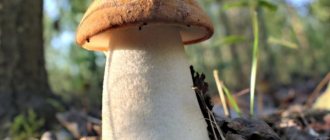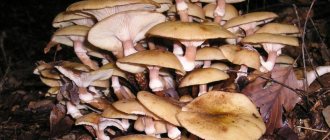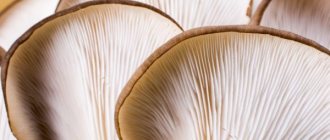Mushrooms
1
1949
Article rating
Kira Stoletova
Mushrooms from the Rowaceae family are highly valued by mushroom pickers. The gray row has an inconspicuous appearance, but it has excellent taste. Inexperienced mushroom pickers often confuse an edible mushroom with a mildly poisonous mushroom. They differ in appearance and smell.
Rowing gray edible
Types of these mushrooms, appearance
Mouse mushrooms belong to the Ryadovkov family, which often do not attract the attention of many mushroom pickers, but have a fairly good taste. The gray row also has the name hatched row, gray row, and pine tree. Mouse mushrooms are edible (see photo and description below), have a dark gray cap and a tall white stalk. Dark streaks descend from the center of the cap to its edges.
Types of edible rows in Crimea
Rowlings are very common in Crimea: about 20 species are found there. They can be collected from late August to late autumn due to the warm climate favorable for mushrooms.
Crowded
Crowded rows are characterized by large hemispherical caps, which open greatly as the mushroom matures. The surface of the caps is smooth, dense and elastic, and has a gray-brown color. The height of the mushroom is up to 10 cm. The stem is thickened, often deformed. May be white or brownish at the base.
Lyophyllum crowded is common in mixed forests, found on forest roads and thinned out edges. Often bears fruit in large clusters. The species is edible and is often used in cooking.
Gigantic
Giant rowers grow in large colonies. The shape of the mushroom cap is semicircular, with rolled edges. Its diameter can reach 20 cm. The stem of the row is very large, massive and dense, mostly cylindrical in shape. The mushroom forms mycorrhiza with pine trees and begins to bear fruit in August.
Gray
Gray rowers are predominantly found on sandy soils in mixed forests dominated by pine trees. They are edible and are consumed only after heat treatment. The species is characterized by convex, outstretched caps with dry, smooth skin. The leg is cylindrical, sometimes curved. It can be white or yellowish, covered with scales.
Earthy
These mushrooms are found in mixed forests under fallen pine needles and leaves. The hat with a diameter of up to 9 cm has the shape of a cone. The row blades are sparse and uneven, with a grayish tint. The pulp is white, practically tasteless and odorless. The fruiting period lasts from August to October.
Mayskaya
May row is widespread in groves, forests and parks, and appears there from April to June. Its main color is light beige, but as the fruit ripens it becomes yellowish. The pulp is fleshy, has a pleasant taste and aroma. The species is edible and is often used in cooking.
Shoed
A characteristic feature of a booted row is long legs deeply embedded in the soil. The caps, like the flesh, are thick and fleshy, growing up to 20 cm in diameter. The caps are usually brownish-brown, and the legs are old and covered with scales. Highly prized in cooking, but difficult to find.
Benefit
Mushrooms should not be consumed by everyone, but their beneficial properties cannot be ignored. With regular but correct consumption of mushrooms, you can increase your immunity, this is especially important in the autumn-winter period. Mice also have antibacterial and antiviral properties and have an anti-inflammatory effect. This nutritional product helps normalize the functioning of the nervous system and cope with fatigue. Mushrooms improve brain function and normalize blood pressure.
Marinated mushrooms in jelly
This cooking method is different in that the green beans are boiled only once, which saves cooking time. At the same time, the pickled gray row does not lose its taste. If you put the jar in the refrigerator for an hour, the marinade will turn into jelly.
Ingredients:
- greens – 3 kg;
- water – 1 l;
- rock salt – about 125 g;
- laurel – 7 leaves;
- citric acid – 1.5 g;
- black pepper – 10 peas;
- cloves – 5-6 pieces;
- allspice – 4 peas.
How to deliciously pickle baby mouse mushrooms:
- Mushrooms are prepared: sorted, cleaned and soaked.
- The rows are placed in a pan, filled with water and boiled over low heat for 10 minutes.
- Then the heat should be increased by adding pepper, bay, cloves and salt to the water with mushrooms.
- As soon as the marinade boils, add citric acid. After this, foam will form, which must be removed periodically. The mushrooms themselves in the marinade need to be stirred from time to time.
- When the greens settle to the bottom and the brine becomes clear, the marinade is ready. All the vinegar is added to it.
- Pickled greens are placed in sterilized jars and rolled up.
Application
In cooking
These mushrooms can be eaten. They turn out very tasty if they are marinated with various seasonings or added to some dish after frying. You can make an excellent cheese and mushroom soup from mice or stew them in sour cream.
In medicine
In medicine, baby mouse mushrooms are used to get rid of excess weight, but at the same time retain all the beneficial substances in the body. In stewed or boiled form, row mushrooms are recommended for diabetes, weak heart or sludge in the body. Mushroom-based lotions and ointments are used in the treatment of skin diseases.
How to cook?
Despite the ordinary taste, far from refined, the earthy row has one positive property. The fact is that the structure of the mushroom can be preserved even during heat treatment. The shape of the fruiting body is not afraid of high temperatures and long-term storage. It does not disintegrate over time, and fiber does not appear in it. Thanks to this, the product is actively used in salting.
When properly prepared, the slightly spicy, spicy taste of the specimen is perfectly revealed and can decorate many dishes. But before cooking, mushrooms must be thoroughly cleaned of sand and soil. To do this, you need to rinse them in cold water, after soaking them for 30-40 minutes.
The next stage of preparation is cooking. Mushrooms do not require aggressive heat treatment. Just bring the water to a boil and you can remove the pan from the heat. Boiling is necessary so that small impurities are finally removed from the fruiting bodies and settle at the bottom of the pan with boiling water. After cooking, the structure of the product is transformed. The mushrooms become more elastic, the fragility goes away.
When the product has gone through all the stages of preliminary preparation, you can give free rein to your imagination. You can cook baby mice in different ways. Some marinate it, others fry it until golden brown. Feel free to experiment.
Even though the taste of the earthy row is not very pronounced and the mushroom is classified in the fourth category, it still deserves attention. Finding it won’t be difficult, but with the right ratio of spices to the main product you can get a real culinary masterpiece.
How to distinguish edible from inedible
False mouse mushrooms (see photo and description below) can mislead you. Beginning mushroom pickers may confuse mouse mushrooms with a poisonous variety - pointed gray row. In this case, the mushrooms differ in their caps. The rows usually grow grayish, with a pointed cap that has a conical shape. As the mushroom grows, the cap becomes flatter, with a small hump at the top. White spore powder collects in the plates on the cap. The poisonous row contains the alkaloid muscarine, which contributes to poisoning of the body.
If you have mushroom poisoning, you may experience:
- nausea;
- vomiting;
- increased salivation;
- sweating;
- diarrhea;
- cutting pain in the abdomen;
- headache;
- blurred vision;
- slowing heart rate;
- pulmonary edema (in severe cases).
Description of baby mushrooms
The cap of a baby mouse can reach a maximum diameter of 9 cm, and its average size is 3-7 cm. In young fruits, it has the shape of a wide cone or bell with tucked edges and a tubercle at the top. In adult mushrooms, the cap is more convex and spread out, with a noticeable tubercle protruding in the center. As a rule, it has a gray or brown-gray color.
Other features of the hat:
- fibrous-scaly;
- silky to the touch;
- As the fruit ripens, the scales and fibers separate slightly, and whitish flesh is visible between them.
- In adult mushrooms, the edges may crack.
The plates of the mice are white (they have a grayish tint, mainly in old mushrooms), wide, attached to the teeth and frequent. The presence of a veil is noted in young mushrooms. It is thin and grayish, cobwebby, and quickly disappears.
The average size of the leg is 3-10 cm in height and up to 2 cm in diameter. The leg is smooth, slightly widened at the base, but fragile, fibrous, white, closer to the cap it has a slight powdery coating. Sometimes a ring zone is visible on it - the remnant of the bedspread.
The spore powder of the fungus is white, the spores themselves are colorless and smooth, broadly ellipsoidal. The flesh of mice is whitish and brittle and does not change color when damaged. It has a pleasant light smell and almost neutral taste.
Poisonous mushrooms of Crimea
grow on the peninsula , but also poisonous ones .
Some of them are very similar to edible ones and can be easily confused by an inexperienced mushroom picker.
Therefore, it is very important to know where to pick mushrooms in Crimea and which ones exactly.
Deadly:
- Death cap. It belongs to the fly agaric genus and is deadly poisonous. Most of the poisonings are caused by this fly agaric. The pale grebe loves fertile soil and grows in mixed deciduous forests. Initially, the cap is in the form of a hemisphere, and as it grows it becomes flat. It has a grayish-greenish color and reaches 15 centimeters in diameter. The thickness of the leg is 2 centimeters, and the height is up to 18 centimeters. In order not to confuse the pale toadstool with a puffball or a champignon, you need to carefully examine the ring around the stem and the membrane on the cap.
- The white fly agaric is a relative of the toadstool. Like the toadstool, the fly agaric cap is initially hemispherical in shape and gradually becomes flat and has a white color. It reaches up to 10 centimeters in diameter. The leg is up to 13 centimeters high and thickens to 2.5 centimeters as it grows. It grows in deciduous forests and prefers calcareous soil.
Use in cooking
Lamellar mushrooms are easy to process, easy to clean, and do not require special cleaning. They are dried, frozen, boiled, fried, stewed. Salt and pickle to preserve for the winter.
In this case, even in February you can surprise your family with an exquisite soup or julienne. Many recipes allow you to prepare a truly royal dish from mushrooms.
Mushroom soup
Rowers are edible mushrooms, but it is better to boil them for 5-10 minutes and pour out the first broth.
After this, they are again immersed in water and brought to a boil. You need to cook them for about 20 minutes until done.
Then the broth is poured into a separate pan, the mushrooms are fried with onions and flour until golden brown, they are combined with liquid, to which a little cream, grated cheese and pre-cooked lentils are added. Before serving, sprinkle with herbs.
Ryadovka stewed in sour cream
Preparation takes approximately 1 hour 10 minutes. You can add champignons, russula, and chanterelles to the dish.
You will need:
- 500 g mushrooms;
- 2 onions;
- fat sour cream;
- vegetable oil;
- spices to taste.
Pre-boil the mushrooms for 20 minutes. in salted water, sauté the onion over low heat with butter.
Then all the products are combined and simmered for another 30 minutes. After adding sour cream and bay leaf with spices, simmer under the lid for 10 minutes. Serve hot.
Mushrooms in batter
You can prepare many delicious dishes from mushrooms
Boil the caps for 10 minutes, allow them to drain and cool. The batter is made from kefir and flour; a beaten egg is added if desired.
Each cap is immersed in the mixture and fried in boiling oil.
Salting for the winter
To prepare you will need:
- rowing – 1 kg;
- water – 1.5 l;
- salt – 3 tbsp;
- black and allspice 5 peas each;
- dried cloves – 3 buds.
The marinade is prepared for 3 minutes, then the mushrooms are immersed in it and simmered over low heat for 45 minutes.
They are distributed into sterilized jars, filled with marinade, and 0.5 tsp is added. vinegar essence (70%) per liter container into the marinade and pour the resulting mixture over the mushrooms. They are sealed tightly, kept under insulation for a day and then stored in a cool, dark place.
Advice. For better salting, the jars are filled 2/3 with mushrooms, the rest is topped up with liquid.
The shelf life is 1 year.
Characteristics of mice
Ryadovka is a lamellar mushroom, part of the family of the same name. Representatives of this group most often live on the sandy soil layer inside coniferous or mixed forests at the base of stumps. In addition, they can be found in artificial plantings, gardens and parks. Their fruiting period is from August to October. Early mushrooms have lighter colored caps.
Appearance and photo
Adult mice are characterized by a dark gray cap with a diameter of 10-12 cm with a small tubercle in the center, a fibrous light leg with a yellowish tint, 2 cm thick and 8 cm high. Long dark stripes extend from the center to the periphery of the cap. Its edges are slightly wavy, with cracks. Under the cap there are wide, thick plates that become thinner at the edges.
In the photo you can see the distinctive features of the variety.
The smooth, dry surface of the cap becomes sticky in rainy weather. Over time, it darkens and signs of rot appear. The edible variety of sulfur row has a pleasant earthy smell.
Structure and species differences
The structure of the cap has two layers: the upper one, covered with an outer crust, and the lower one, which is formed with the help of numerous rare wide plates. As they age, they change color from white to gray with yellow spots. They accumulate white spore powder. The spores themselves are colorless, ovoid in shape. The flesh at the break takes on a yellow tint.
Places of distribution: Crimea, Mariupol, Novorossiysk and others
Until recently, it was believed that baby mice grew exclusively in the south. Most often they were found in Crimea, Mariupol, Novorossiysk in coniferous, mixed forests and plantings among needles or leaves. This species grows in rows or groups near pines, forming mycorrhiza with them. Fruits from late summer until the first frost. Today it is known that this mushroom lives throughout the temperate climate zone. This species is found even in Western Siberia.
Consumption" in food
You can distinguish both edible and inedible and poisonous mice. Gray row is characterized by excellent taste. It can be dried, salted, pickled, and also subjected to heat treatment (boiled or fried). Both young and mature mushrooms that are not bitter are suitable for consumption.
Are there any differences between Crimean mouse pups and other gray mice?
The best living conditions for mice are the humid, warm climate of Crimea and Novorossiysk. These mushrooms settle in soil rich in moss and rotted fallen leaves.
Rules and meeting places
Mice tolerate low temperatures well. They can be found even under the snow. Crimean mushroom pickers recommend looking for them in the vicinity of Sevastopol, the village of Kolchugino, among the mountain forests of Ai-Petri and Demerdzhi. The Bakhchisarai region is famous for its abundance of mushroom species.
Distribution and collection
The distribution area of the sulfur row is quite wide, it is almost the entire temperate European zone, partly the subtropical zone. It grows in groups, often quite large, forming concentric circles and semicircles, popularly called “witch rings”. Prefers deciduous and mixed forests, mainly with sandy soils and soils with lime admixtures.
Collection time is from September until the first severe frosts.
Useful properties of mice and restrictions on use
These mushrooms are a storehouse of vitamins, protein, minerals, unique amino acids and other useful substances. In addition, mice have pronounced antibacterial and anti-inflammatory properties.
Thanks to their composition, they help strengthen the immune system, improve the functioning of the heart, normalize blood pressure, and prevent the development of tuberculosis and cancer. They have a positive effect on digestion, strengthen blood vessels, cleanse the liver, activate the brain, and normalize blood sugar levels.
Recipes and cooking features
Young mice are characterized by more pronounced taste qualities. They can be boiled, fried, salted, pickled, and also used to prepare minced meat, sauces and salads.
Before cooking, it is recommended to clean the caps from the outer film and thoroughly rinse the mushrooms several times. Boil in lightly salted water for 20 minutes. Fried mice go well with meat, vegetables, eggs and various side dishes. Delicious caviar is prepared from some of the rows.
Marinating them is quite simple, following this recipe:
- First boil, skimming off the foam.
- Place the mushrooms inside the jars, adding bay leaves, cloves, and allspice.
- Prepare a marinade from water (0.5 l), sugar (1 tsp), salt (2 tbsp) and vinegar (5 tbsp).
- Pour boiling marinade over the mushroom preparation and close with a lid.
Pickled rows
A simple cold brew recipe
Pine trees are well suited for pickling. Here's one option. Ingredients for 10 kg of mushrooms:
- salt – 400 g;
- garlic, dill and peppercorns - to your taste;
- currant leaves, horseradish leaves - 5-6 pieces;
- laurel - about 8 - 10 leaves.
How to pickle rows:
- The mushrooms are cleaned and soaked for about 3 hours in salted water.
- Next, you should cut the fruits, separating the caps and stems. If the mice are small, you don’t have to do this.
- Place the mushrooms, stems up, into a wooden tub or large saucepan that has been cleanly washed and scalded with boiling water. Each layer should be sprinkled with salt and selected herbs and spices.
- After laying the greenery, place a plate or a clean wooden circle on top, and place pressure on it.
- In the period from 30 to 40 days, the mushrooms should be well salted, then they can be used for food.
IMPORTANT! When laying rows in a tub, the last layer should be a layer of herbs and spices so that the mushrooms do not become moldy.
